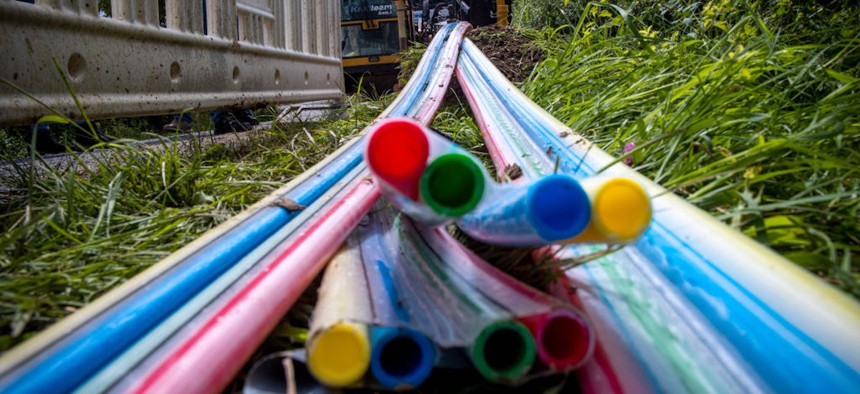Leveraging smart grid upgrades for broadband buildout

Photo by Jens Büttner/picture alliance via Getty Images
New legislation would provide a federal cost-share in a bid to spur broadband infrastructure investment along the electricity grid.
Bipartisan legislation recently introduced in the Senate would provide a federal cost-share to encourage the buildout of new fiber optic broadband infrastructure along the nation’s existing electricity grid.
The bill would establish a grant program at the National Telecommunications and Information Administration that would award funds to governments and organizations that install new fiber connectivity as they upgrade middle-mile infrastructure of the electric grid. Grant recipients would be required to use the funding to simultaneously improve the cybersecurity and smart grid technology of their electrical grids.
The legislation is in keeping with dig-once policies that look to reduce the amount of construction along the same rights-of-way, and lawmakers said they hope the legislation would encourage more broadband internet options while improving the resilience of electrical grids. Supporters said it will also create thousands of jobs and set the stage for long-term economic growth.
In a statement, Senate Commerce Committee Chair Maria Cantwell (D-Wash.), who introduced the bill, called it a “triple win solution for consumers because it leverages existing rights-of-way and private sector ingenuity and investment to deliver cleaner electricity, stronger cybersecurity, and more accessible broadband services.”
States are increasingly looking to boost connectivity along their middle-mile infrastructure while avoiding multiple construction projects through dig-once policies. This week, the South Dakota Department of Transportation (SDDOT) and the Governor’s Office of Economic Development launched an effort to increase cooperation between the state government and broadband providers.
Dave Huft, SDDOT’s intelligent transportation systems manager and broadband communication coordinator, said in a statement that state-level effort aims in part to “minimize repeated costly excavations to install broadband infrastructure in and along highway rights of way.”
Similarly, the Pennsylvania Turnpike Commission said last year it would install a high-speed optical network along a portion of its highway that aims to upgrade communications and prepare for new safety and mobility technologies while also providing an avenue to make broadband available to underserved communities through fiber infrastructure leasing.
In a statement accompanying Cantwell’s legislation, George Caan, executive director of the Washington Public Utility Districts Association, said it is a “novel effort as a mechanism to bring connectivity technologies to our state and around the nation” that could help bring affordable energy and affordable internet to underserved communities.
NEXT STORY: The power of no-code to modernize government






